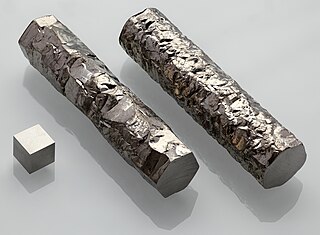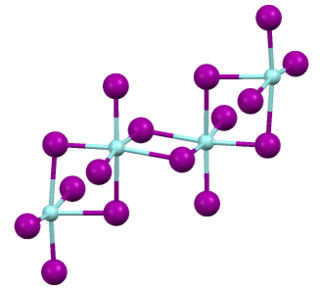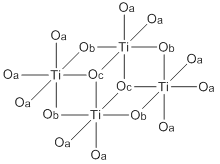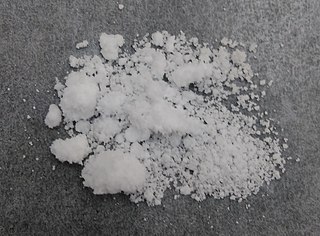Related Research Articles

Zirconium is a chemical element; it has symbol Zr and atomic number 40. The name zirconium is derived from the name of the mineral zircon, the most important source of zirconium. The word is related to Persian zargun. It is a lustrous, grey-white, strong transition metal that closely resembles hafnium and, to a lesser extent, titanium.

Hafnium(IV) chloride is the inorganic compound with the formula HfCl4. This colourless solid is the precursor to most hafnium organometallic compounds. It has a variety of highly specialized applications, mainly in materials science and as a catalyst.

Zirconium carbide (ZrC) is an extremely hard refractory ceramic material, commercially used in tool bits for cutting tools. It is usually processed by sintering.

Zirconium(IV) chloride, also known as zirconium tetrachloride, is an inorganic compound frequently used as a precursor to other compounds of zirconium. This white high-melting solid hydrolyzes rapidly in humid air.

Zirconium silicate, also zirconium orthosilicate, ZrSiO4, is a chemical compound, a silicate of zirconium. It occurs in nature as zircon, a silicate mineral. Powdered zirconium silicate is also known as zircon flour.
Zirconium(IV) bromide is the inorganic compound with the formula ZrBr4. This colourless solid is the principal precursor to other Zr–Br compounds.

Zirconium(IV) fluoride describes members of a family inorganic compounds with the formula (ZrF4(H2O)x. All are colorless, diamagnetic solids. Anhydrous Zirconium(IV) fluoride' is a component of ZBLAN fluoride glass.

Zirconium(IV) iodide is the chemical compound with the formula ZrI4. It is the most readily available iodide of zirconium. It is an orange-coloured solid that degrades in the presence of water. The compound was once prominent as an intermediate in the purification of zirconium metal.
Titanium(III) phosphide (TiP) is an inorganic chemical compound of titanium and phosphorus. Normally encountered as a grey powder, it is a metallic conductor with a high melting point. It is not attacked by common acids or water. Its physical properties stand in contrast to the group 1 and group 2 phosphides that contain the P3− anion (such as Na3P), which are not metallic and are readily hydrolysed. Titanium phosphide is classified as a "metal-rich phosphide", where extra valence electrons from the metal are delocalised.

Zirconium(III) chloride is an inorganic compound with formula ZrCl3. It is a blue-black solid that is highly sensitive to air.

Titanium ethoxide is a chemical compound with the formula Ti4(OCH2CH3)16. It is a commercially available colorless liquid that is soluble in organic solvents but hydrolyzes readily. Its structure is more complex than suggested by its empirical formula. Like other alkoxides of titanium(IV) and zirconium(IV), it finds used in organic synthesis and materials science.

Hafnium tetrafluoride is the inorganic compound with the formula HfF4. It is a white solid. It adopts the same structure as zirconium tetrafluoride, with 8-coordinate Hf(IV) centers.

Zirconium nitrate is a volatile anhydrous transition metal nitrate salt of zirconium with formula Zr(NO3)4. It has alternate names of zirconium tetranitrate, or zirconium(IV) nitrate.

Pentamethyltantalum is a homoleptic organotantalum compound. It has a propensity to explode when it is melted. Its discovery was part of a sequence that lead to Richard R. Schrock's Nobel Prize discovery in olefin metathesis.
Zinc diphosphide (ZnP2) is an inorganic chemical compound. It is a red semiconductor solid with a band gap of 2.1 eV. It is one of the two compounds in the zinc-phosphorus system, the other being zinc phosphide (Zn3P2).
Carbide chlorides are mixed anion compounds containing chloride anions and anions consisting entirely of carbon. In these compounds there is no bond between chlorine and carbon. But there is a bond between a metal and carbon. Many of these compounds are cluster compounds, in which metal atoms encase a carbon core, with chlorine atoms surrounding the cluster. The chlorine may be shared between clusters to form polymers or layers. Most carbide chloride compounds contain rare earth elements. Some are known from group 4 elements. The hexatungsten carbon cluster can be oxidised and reduced, and so have different numbers of chlorine atoms included.

Zirconium(III) iodide is an inorganic compound with the formula ZrI3.
Hafnium compounds are compounds containing the element hafnium (Hf). Due to the lanthanide contraction, the ionic radius of hafnium(IV) (0.78 ångström) is almost the same as that of zirconium(IV) (0.79 angstroms). Consequently, compounds of hafnium(IV) and zirconium(IV) have very similar chemical and physical properties. Hafnium and zirconium tend to occur together in nature and the similarity of their ionic radii makes their chemical separation rather difficult. Hafnium tends to form inorganic compounds in the oxidation state of +4. Halogens react with it to form hafnium tetrahalides. At higher temperatures, hafnium reacts with oxygen, nitrogen, carbon, boron, sulfur, and silicon. Some compounds of hafnium in lower oxidation states are known.
Neptunium(III) phosphide is a binary inorganic compound of neptunium metal and phosphorus with the chemical formula NpP.
Zirconium monophosphide is a binary inorganic compound of zirconium metal and phosphorus with the chemical formula ZrP.
References
- ↑ Chemical Thermodynamics of Zirconium. Elsevier. 6 December 2005. p. 477. ISBN 978-0-08-045753-6 . Retrieved 7 March 2024.
- 1 2 Macintyre, Jane E. (23 July 1992). Dictionary of Inorganic Compounds. CRC Press. p. 3769. ISBN 978-0-412-30120-9 . Retrieved 7 March 2024.
- ↑ Grushko, Ya M. (28 May 1992). Handbook of Dangerous Properties of Inorganic And Organic Substances in Industrial Wastes. CRC Press. p. 750. ISBN 978-0-8493-9300-6 . Retrieved 7 March 2024.
- ↑ "Crystal structure of zirconium diphosphide, ZrP 2". Zeitschrift für Kristallographie - Crystalline Materials . 209 (4): 370. 1 April 1994. doi:10.1524/zkri.1994.209.4.370 . Retrieved 7 March 2024.
- ↑ "mp-1523: ZrP2 (orthorhombic, Pnma, 62)". Materials Project . Retrieved 7 March 2024.
- ↑ "циркония дифосфид - свойства, реакции". chemister.ru. Retrieved 7 March 2024.